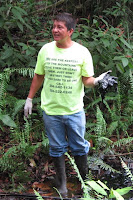When I was in Kenya, often times our team would go to some location – a church, a school, a worship service – and we’d spontaneously be asked to perform a song. The first time we had to do this, I believe we were at our local church, and we decided that the easiest, simplest, shortest song that everyone knew how to sing was “Step by Step.” If you’ve ever been to church in your life, ever, I’m guessing you know the one I’m taking about – “God you are my God, and I will ever praise you…I will seek you in the morning, and I will learn to walk in your ways, and step by step you’ll lead me…and I will follow you all of my days.” After about the second or third time of being asked to sing on-the-spot in front of a group of people, it kind of became assumed that we would always just use our go-to, SUPER exiting and elaborate song, Step by Step (kidding about the exciting part). By the end of the trip, we had done this so many times, that not only was everyone incredibly sick of this particular song, but it became somewhat of a running joke that it was the only one we EVER sang when asked to sing for other people. I swear to you I actually had a dream one night, while in Kenya, that I was leading worship for a huge conference somewhere, and when I got up on stage to start singing, the ONLY song I could remember the words/tune to was Step by Step. I’m not kidding. I woke up laughing.
Well, I personally believe that God has a pretty amusing sense of humor, because now I’m here in Ecuador, finding myself many times easily discouraged or frustrated or homesick, and the words of that song – while incredibly simple – have never been such a beautiful reminder. Take it step by step, day by day – God’s been placing those words on my heart over and over – and I will lead you. I’ve heard many pastors and speakers use the analogy of God leading us like a father leads their toddler when teaching them how to walk. They take one step, maybe two, before they inevitably fall down. But a father never gives up on his child. He picks them back up, when they’re ready, and continues to lead them, slowly and patiently. I’ve had that image go through my mind a lot recently – it’s at times what I feel this season of my life has metaphorically looked like, like I'm only able to make it one or two steps before something knocks me back down, or I lose my own balance and forget that I need God to hold me. It’s incredibly tiring, and not at all easy to be patient and persevering, especially with my personality that seems inclined to go about a million miles an hour without really pausing to breathe. But God is teaching me this semester something that I have needed to learn for YEARS – that when I’ve overwhelmed with emotion or stress or whatever it may be, I need to slow down, allow myself space and time to relax, and choose to take it step by step, day by day.
I had to make a difficult decision last week – I decided to withdraw from one of my classes. The migraine I mentioned in my last post ended up lasting for over two weeks (part of the reason I haven’t blogged in so long) – coming in cluster headaches and residual migraine pain that didn’t let up until only about 5 days ago. I am suspicious that it may have had something to do with the high altitude, but I am close to positive that the emotional and mental stress I have been dealing with, combined with all the changes and adjustments that go along with living in a different country, also had a huge part to do with it. Either way, my health (in all respects of the word) was quickly waning, and on top of everything else we had just begun our graduate-level class which was entirely in Spanish and met 6 hours a week. Pretty much needless to say, I absolutely could not handle it on top of everything else going on. So instead of doing what I usually do – sucking it up and letting myself stay stressed and anxious – I made the decision to withdraw and use the extra time in my schedule to relax and rest. You may be thinking, “well of course you needed to do that, that’s an easy decision to make,” but that wasn’t exactly how I felt at the time. I don’t give up easily and I don’t like the feeling of failure at ALL, and I’m terrible at saying no to things even when I know I don’t have time for them (although I have gotten much better at that since the beginning of college). But once I made the decision, I KNEW it was the best thing I could have done. It was a step in the right direction and a step towards learning how to better take care of myself.
My friend posted this quote on her Facebook a while back, and I thought it was perfectly “in theme” with this blog: “If God sends us on stony paths, He will provide us with strong shoes” (Alexander MacLaren). I love this image of walking down a road equipped with God’s power leading our feet. So, with the “strong shoes” I trust that God has given me, I’m taking it step by step, one day at a time. And when I do fall, He is providing me daily with the strength to pick myself back up, and keep walking this journey.




